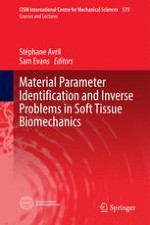2017 | OriginalPaper | Chapter
3. How Can We Measure the Mechanical Properties of Soft Tissues?
Author : Sam Evans
Published in: Material Parameter Identification and Inverse Problems in Soft Tissue Biomechanics
Publisher: Springer International Publishing
Activate our intelligent search to find suitable subject content or patents.
Select sections of text to find matching patents with Artificial Intelligence. powered by
Select sections of text to find additional relevant content using AI-assisted search. powered by
